#Gebhard Leberecht von Blücher
Text
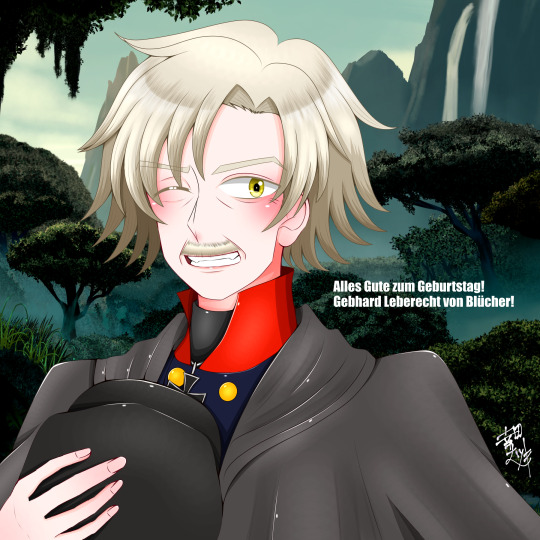
Vorwärts!
10 notes
·
View notes
Text
Bonus Round: Best General


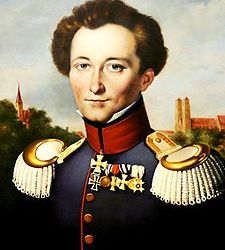

Prince Heinrich of Prussia (1726–1802)
Prinz Heinrich prominently served as a general during the Seven Year's War. What contemporaries and historians alike have found so impressive about his leadership was that he made so few, if any, blunders in carrying out the war. This was a sentiment echoed by his brother, Frederick the Great, who absorbs much of the credit by osmosis. His victories and maneuvers allowed his brother to carry on a war that the prince would have preferred to be ended sooner than 1756. Outside of war, he is his own colorful character, in line with that generation of Hohenzollern men and women.
Gebhard Leberecht von Blücher (1742-1819)
What hot blooded Prussian does not know the name Blücher? It is he we have to thank for the defeat of the villain Napoleon - not once, but twice! The first great defeat at Leipzig restored Prussia to her place of due prominence among the nations of Europe. At Waterloo, he and his troops arrived as Wellington's guardian angels to defeat the Corsican devil. The main army battered, the reserves shunted away, Blücher became an immortal hero to all who opposed shrimpy French tyranny.
Carl von Clausewitz (1780-1831)
Clausewitz's greatest achievement is his book Vom Krieg (On War), a tome that rewrote the rules of conflict for a post Napoleonic age. Among many of the revolutionary ideas contained with in it, a few to highlight are the "fog of war", the concept of friction and the idea of a military genius.
Helmuth von Moltke the Elder (1800-1891)
As Chief of the Prussian General Staff, Moltke worked hand in hand with War Minister von Roon to deliver three swift victories for the Prussian state. It was his genius on display during Königgratz, during Sedan and Metz and Gravelotte. Without him, Prussia's ascendancy and Germany's unification would not have been possible.
Moltke understood that with the growing size of modern armies, generalship such as that underneath Napoleon or Blücher was unfeasible. Instead of a general leading his army as a whole, Motlke devised a corp system wherein smaller clusters of troops would move independently of each other — Theodor, get your hands off of me!
#hohenzollern bracket#bonus round#prince henry of prussia#prinz heinrich von preussen#gebhard von blücher#carl von clausewitz#moltke the elder#staffer theodor#staffer leopold
27 notes
·
View notes
Text

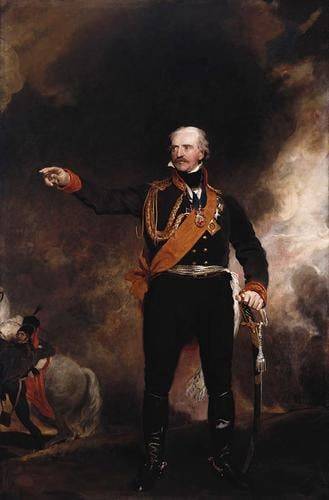
Commander of the Prussian army. Formerly a general of the cavalry regiment, he fought against Bonapi. Has a rough and fiery temper but kind to his subordinates. Possess intense hatred towards Bonapi.
Gebhard Leberecht von Blücher
24 notes
·
View notes
Text
De Waterloostraat in 1950.
Deze straat werd aangelegd in 1865, toen het halve eeuwfeest van de slag bij Waterloo werd gevierd. In juni van dat jaar wordt de naam voor het eerst vermeld. Ze is door de bouwondernemer gegeven.
De Slag bij Waterloo was een veldslag bij Waterloo, een plaatsje destijds gelegen in de Zuidelijke Nederlanden, tegenwoordig in België. Napoleon Bonaparte werd hier op 18 juni 1815 definitief verslagen door een coalitie van enerzijds Britse, Nederlandse en Hannoverse eenheden onder opperbevel van de hertog van Wellington en anderzijds een Pruisisch leger onder commando van maarschalk Gebhard Leberecht von Blücher. De 19e-eeuwse Britse historicus Edward Creasy rekende de Slag bij Waterloo onder de vijftien meest beslissende veldslagen in de wereldgeschiedenis.
Na in 1814 verbannen te zijn naar Elba, keerde Napoleon in maart 1815 naar Frankrijk terug. Hij installeerde zich daar opnieuw als keizer van Frankrijk. Zijn oude vijanden konden dat niet aanvaarden en vormden de Zevende Coalitie om hem weer te verjagen. Engeland en Pruisen trokken grote legers samen in de zuidelijke Nederlanden om Frankrijk op 1 juli 1815 binnen te vallen. Napoleon besloot ze voor te zijn en trok op 14 juni de grens van het Verenigd Koninkrijk der Nederlanden over bij Charleroi. De beslissende slag vond plaats bij Waterloo.
De foto is gemaakt door de Fototechnische Dienst Rotterdam en komt uit het Stadsarchief Rotterdam. De informatie komt eveneens uit het Stadsarchief Rotterdam en van Wikipedia.
Bericht van 2021

0 notes
Text
The Battle of Waterloo

Standing on the snow-covered field of Waterloo, the cold ran down my spine as the ghosts of sacrificed soldiers whispered on the win. The air smelled of gunpowder and blood. In the distance hearing rumbles of cannons implemented the clash between the enemies. The battle raged around me, and I witnessed the tense combat and the continuous battle of who fought for kings and country. Amidst the snow, mud, and devastation, Napoleon’s dream of an empire met its last battle before his loss (Original source, Wellingtons Campaign).
The Battle of Waterloo was not just a military engagement, but it was a collision of empires and a battle for supremacy that shaped European history for many generations to come (Consulate/1st French Empire).As it reached dawn and the cries of the wounded faded into the rest of the night, Napoleon's dreams of power and empire shattered on the bloody fields of Waterloo.
The Battle of Waterloo marked the end of an era and the beginning of a new era in European history. It was here and engraved around Napoleon’s resignation and conquests. It came crashing down and forces and order prevailed. The Battle of Waterloo stayed as a legacy and endured as a testament to the human spirit. It reminded us that even during the darkest times of history, hope can still prevail (Consulate/1st French Empire).
More Detail:
The Battle of Waterloo was fought on June 18, 1815. It was a private conflict in European history. The battle took place near Waterloo, Belgium, and was fought by French forces that were led by Napoleon. They faced a coalition of British, Belgian, Dutch, and Prussian armies under the command of the Duke of Wellington and Field Marshal Gebhard Leberecht von Blücher. It resulted in victory for the coalition forces ending Napoleon’s rule as Emperor of the French and ending to Napoleonic Wars. The Battle of Waterloo lasted approximately 9 hours from 11:30 AM to 8:30 PM on June 18, 1815. Napoleon lost over 40,000 men and the Allies suffered about 22,000 casualties. It resulted in an extremely bloody battle. (Consulate/1st French Empire).
0 notes
Text
Unveiling the Timeless Elegance: Derby Shoes for Party Wear and Wedding Shoe
When it comes to footwear that effortlessly combines style, comfort, and versatility, Derby shoes have always been a top choice. These classic shoes have stood the test of time and continue to be a staple in both men's and women's fashion. Whether you're attending a party or preparing for a wedding, Derby shoes are the perfect option to complete your ensemble and make a statement with your footwear.
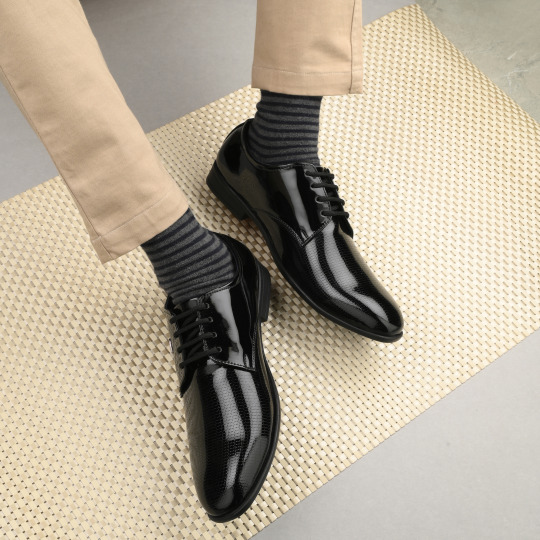
History and Origins of Derby Shoes
Derby shoes have a rich history that dates back to the 19th century. Originally known as "bluchers," these shoes were named after the Prussian general Gebhard Leberecht von Blücher. The design of Derby shoes is characterized by open lacing, where the eyelets are sewn on top of the vamp. This distinctive feature sets them apart from other formal shoes like Oxfords, which have closed lacing.
Explore our Berkins Collection of Iconic Shoes and Creative Design. Shop Now and Make a Statement with Your Footwear!
At Berkins, we take pride in offering a wide range of Derby shoes that cater to different tastes and preferences. Our collection features iconic designs crafted with attention to detail and impeccable craftsmanship. From classic leather Derby shoes to more contemporary styles with unique patterns and textures, we have something for everyone. Whether you're looking for a pair to wear to a party or to complement your wedding attire, our Berkins collection has you covered. Explore our range now and elevate your style with our timeless Derby shoes.
Features and Characteristics of Derby Shoes
Derby shoes are known for their distinctive features and characteristics that set them apart from other types of footwear. One of the key features is the open lacing system, which allows for a more adjustable fit and makes them suitable for different foot sizes and shapes. The comfortable and spacious construction of Derby shoes also makes them a great choice for extended wear, ensuring your feet stay comfortable throughout the day or night.
Additionally, Derby shoes often feature a slightly chunkier sole and a more casual aesthetic compared to formal shoes like Oxfords. This makes them a versatile option that can be dressed up or down depending on the occasion. Whether you're pairing them with jeans and a blazer for a party or wearing them with a suit for a wedding, Derby shoes effortlessly add a touch of sophistication to any outfit.
Why Derby Shoes are Perfect for Party Wear
When it comes to party wear, Derby shoes are a perfect choice for several reasons. Firstly, their versatility allows you to style them in various ways to suit different party themes and dress codes. Whether you're attending a casual gathering or a more formal event, Derby shoes can be dressed up or down accordingly.
Secondly, Derby shoes offer the perfect balance between style and comfort. Parties often involve a lot of standing and dancing, and the last thing you want is uncomfortable footwear slowing you down. Derby shoes provide the ideal combination of support and cushioning, allowing you to enjoy the festivities without sacrificing your comfort.
Lastly, Derby shoes exude a timeless elegance that adds a touch of sophistication to any party outfit. Their classic design and refined aesthetic make them a versatile choice that can elevate your look while still keeping it appropriate for the occasion. Whether you opt for a traditional black leather pair or choose a more unique and eye-catching design, Derby shoes are sure to make a statement at any party.
How to Style Derby Shoes for Different Party Occasions
Styling Derby shoes for different party occasions is all about finding the right balance between formal and casual. Here are some tips to help you create the perfect look:
Casual Parties: Pair your Derby shoes with dark-wash jeans or chinos for a relaxed yet polished look. Add a crisp white shirt or a stylish polo shirt to complete the ensemble. You can also experiment with different colors and patterns for a more playful vibe.
Semi-Formal Parties: Opt for a pair of Derby shoes in a classic color like black or brown. Pair them with tailored trousers and a button-down shirt for a sophisticated and put-together look. You can also add a blazer or a sports jacket for an extra touch of elegance.
Formal Parties: For formal events, choose a pair of Derby shoes in a high-quality leather finish. Pair them with a tailored suit in a complementary color. Stick to neutral tones for a timeless and refined look. Complete the outfit with a dress shirt, a tie, and pocket square for a polished appearance.
Remember, the key to styling Derby shoes for parties is to strike the right balance between comfort and style. Experiment with different combinations to find the look that suits your personal style and the occasion.
Why Derby Shoes are a Popular Choice for Wedding Attire
Derby shoes have become increasingly popular as a choice for wedding attire, and for good reason. Weddings are special occasions that require a balance between style and comfort, and Derby shoes offer the perfect solution.
One of the reasons why Derby shoes are popular for weddings is their versatility. Whether you're the groom, a groomsman, or a guest, Derby shoes can be styled to suit different wedding themes and dress codes. From formal black-tie weddings to more relaxed outdoor ceremonies, Derby shoes can be adapted to complement any wedding ensemble.
Another reason why Derby shoes are favored for weddings is their timeless elegance. Their classic design and refined aesthetic add a touch of sophistication to any wedding attire. Whether you're wearing a traditional suit or opting for a more contemporary wedding outfit, Derby shoes effortlessly elevate your look and make a statement.
Lastly, Derby shoes prioritize comfort without compromising on style. Wedding days can be long, and you'll be on your feet for extended periods. With their comfortable construction and spacious fit, Derby shoes ensure that your feet stay happy and pain-free throughout the celebration.
Tips for Choosing the Right Derby Shoes for a Wedding
Choosing the right Derby shoes for a wedding involves considering a few key factors. Here are some tips to help you make the perfect choice:
Color: Consider the color scheme of the wedding and choose a pair of Derby shoes that complements it. Classic black or brown are versatile options that work well with most wedding themes. If the dress code allows for more creativity, you can opt for colored or two-tone Derby shoes to add a unique touch to your ensemble.
Material: High-quality leather is always a safe choice for wedding shoes. It exudes sophistication and ensures durability. However, if you're attending a more relaxed or outdoor wedding, you can also consider Derby shoes made from suede or other materials that offer a more casual and laid-back vibe.
Style: Consider the overall aesthetic of your wedding outfit and choose a Derby shoe style that complements it. Whether you prefer a classic plain toe design or a more intricate brogue detailing, make sure the style of the shoe enhances your overall look.
Fit: A proper fit is essential for comfort, especially during long wedding celebrations. Take the time to measure your feet accurately and try on different sizes to find the perfect fit. Remember that your feet may swell throughout the day, so opt for a slightly roomier fit to accommodate this.
How to Pair Derby Shoes with Wedding Outfits
Pairing Derby shoes with wedding outfits is all about creating a harmonious and well-coordinated look. Here are some ideas to inspire your styling:
Classic Suit: If you're wearing a classic suit, opt for a black or brown pair of Derby shoes in a high-quality leather finish. This timeless combination exudes elegance and complements the formal nature of the suit. Complete the look with a matching belt for a polished appearance.
Contemporary Wedding Outfit: For a more contemporary wedding outfit, consider experimenting with different colors and materials. Pair a navy blue suit with a pair of brown suede Derby shoes for a modern and stylish look. You can also mix and match patterns and textures to add visual interest to your ensemble.
Outdoor Wedding Attire: If you're attending an outdoor wedding, choose Derby shoes with a more casual aesthetic. Opt for lighter colors like tan or gray and pair them with linen trousers or chinos. This creates a relaxed and effortless look that is perfect for an outdoor celebration.
Remember, the key to pairing Derby shoes with wedding outfits is to ensure a cohesive and well-balanced look. Pay attention to details such as color, material, and style to create an ensemble that is both stylish and appropriate for the occasion.
Where to Buy Derby Shoes for Party Wear and Wedding Attire
When it comes to purchasing Derby shoes for party wear and wedding attire, quality and craftsmanship are of utmost importance. At Berkins, we offer a wide range of Derby shoes that meet these criteria. Our collection features a variety of styles, colors, and materials to suit different tastes and preferences. Visit our website to explore our collection and find the perfect pair of Derby shoes to elevate your style.
Conclusion
Derby shoes have stood the test of time and continue to be a versatile and timeless choice for both party wear and wedding attire. With their distinctive features, comfortable construction, and refined aesthetic, Derby shoes effortlessly combine style and comfort. Whether you're attending a party or preparing for a wedding, a pair of Derby shoes will make a statement and add a touch of elegance to your ensemble. So, why wait? Explore our Berkins collection now and discover the perfect pair of Derby shoes to complement your style.
CTA: Explore our Berkins collection of iconic shoes that have revolutionized fashion trends throughout history. Shop now and make a statement with your footwear!
1 note
·
View note
Text

Freilich Magazin: » Der schlohweiße Husar – Zum Geburtstag von Gebhard Leberecht von Blücher http://dlvr.it/T0CjkW «
0 notes
Text
On this day in Wikipedia: Tuesday, 12th September
Welcome, Bienvenida, नमस्ते, שלום 🤗
What does @Wikipedia say about 12th September through the years 🏛️📜🗓️?

12th September 2019 🗓️ : Death - ʻAkilisi Pōhiva
ʻAkilisi Pōhiva, Tongan politician and activist, Prime Minister of Tonga (b. 1941)
"Samiuela ʻAkilisi Pōhiva (7 April 1941 – 12 September 2019) was a Tongan pro-democracy activist and politician. Pohiva, the leader of the Democratic Party of the Friendly Islands (DPFI), served as the Prime Minister of Tonga from 2014 to his death in 2019. He was only the fourth commoner to serve as..."

Image licensed under CC BY 2.0? by ITU Pictures
12th September 2018 🗓️ : Death - Shen Chun-shan
Shen Chun-shan, Taiwanese academic (b. 1932)
"Shen Chun-shan (29 August 1932 – 12 September 2018) was a Taiwanese physicist who served as president of National Tsing Hua University from 1994 to 1997. He was known as one of the "four princes of Taiwan" along with Chen Li-an, Fredrick Chien, and Lien Chan, all of whose fathers attained prominence..."

Image licensed under CC0? by Ajenw at Chinese Wikipedia
12th September 2013 🗓️ : Event - NASA
NASA confirms that its Voyager 1 probe has become the first manmade object to enter interstellar space.
"The National Aeronautics and Space Administration (NASA ) is an independent agency of the U.S. federal government responsible for the civil space program, aeronautics research, and space research. Established in 1958, NASA succeeded the National Advisory Committee for Aeronautics (NACA) to give the..."

Image by National Aeronautics and Space Administration
12th September 1973 🗓️ : Birth - Paul Walker
Paul Walker, American actor (d. 2013)
"Paul William Walker IV (September 12, 1973 – November 30, 2013) was an American actor. He was best known for his role as Brian O'Conner in the Fast & Furious franchise. Paul Walker began his career as a child actor in the 1980s, gaining recognition in the 1990s after appearing in the television soap..."

Image licensed under CC BY-SA 3.0? by Andre Luis
12th September 1923 🗓️ : Event - Southern Rhodesia
Southern Rhodesia, today called Zimbabwe, is annexed by the United Kingdom.
"Southern Rhodesia was a landlocked self-governing British Crown colony in southern Africa, established in 1923 and consisting of British South Africa Company (BSAC) territories lying south of the Zambezi River. The region was informally known as south Zambesia until annexed by Britain at the behest..."

Image by Greentubing (original)
12th September 1819 🗓️ : Death - Gebhard Leberecht von Blücher
Gebhard Leberecht von Blücher, Prussian general (b. 1742)
"Gebhard Leberecht von Blücher, Fürst von Wahlstatt (German pronunciation: [ˈɡɛphaʁt ˈleːbəʁɛçt fɔn ˈblʏçɐ]; 21 December 1742 – 12 September 1819), Graf (count), later elevated to Fürst (sovereign prince) von Wahlstatt, was a Prussian Generalfeldmarschall (field marshal). He earned his greatest..."

Image by After Ernst Gebauer
12th September 🗓️ : Holiday - Defenders Day (Maryland, United States)
"Defenders Day is a longtime legal holiday on September 12, in the U.S. state of Maryland, in the City of Baltimore and surrounding Baltimore County. It commemorates the successful defense of the city of Baltimore on September 12-13-14, 1814 from an invading British force during the War of 1812, an..."
0 notes
Text
Events 6.18
618 – Li Yuan becomes Emperor Gaozu of Tang, initiating three centuries of Tang dynasty rule over China.
656 – Ali becomes Caliph of the Rashidun Caliphate.
860 – Byzantine–Rus' War: A fleet of about 200 Rus' vessels sails into the Bosphorus and starts pillaging the suburbs of the Byzantine capital Constantinople.
1053 – Battle of Civitate: Three thousand Norman horsemen of Count Humphrey rout the troops of Pope Leo IX.
1178 – Five Canterbury monks see an event believed to have been the formation of the Giordano Bruno crater on the moon. It is believed that the current oscillations of the Moon's distance from the Earth (on the order of meters) are a result of this collision.
1264 – The Parliament of Ireland meets at Castledermot in County Kildare, the first definitively known meeting of this Irish legislature.
1265 – A draft Byzantine–Venetian treaty is concluded between Venetian envoys and Emperor Michael VIII Palaiologos, but is not ratified by Doge Reniero Zeno.
1429 – Charles VII's army defeats an English army under John Talbot at the Battle of Patay during the Hundred Years' War. The English lost 2,200 men, over half their army, crippling their efforts during this segment of the war.
1633 – Charles I is crowned King of Scots at St Giles' Cathedral, Edinburgh.
1684 – The charter of the Massachusetts Bay Colony is revoked via a scire facias writ issued by an English court.
1757 – Battle of Kolín between Prussian forces under Frederick the Great and an Austrian army under the command of Field Marshal Count Leopold Joseph von Daun in the Seven Years' War.
1778 – American Revolutionary War: The British Army abandons Philadelphia.
1799 – Action of 18 June 1799: A frigate squadron under Rear-admiral Jean-Baptiste Perrée is captured by the British fleet under Lord Keith.
1803 – Haitian Revolution: The Royal Navy led by Rear-Admiral John Thomas Duckworth commence the blockade of Saint-Domingue against French forces.
1812 – The United States declaration of war upon the United Kingdom is signed by President James Madison, beginning the War of 1812.
1815 – Napoleonic Wars: The Battle of Waterloo results in the defeat of Napoleon Bonaparte by the Duke of Wellington and Gebhard Leberecht von Blücher forcing him to abdicate the throne of France for the second and last time.
1822 – Konstantinos Kanaris blows up the Ottoman navy's flagship at Chios, killing the Kapudan Pasha Nasuhzade Ali Pasha.
1858 – Charles Darwin receives a paper from Alfred Russel Wallace that includes nearly identical conclusions about evolution as Darwin's own, prompting Darwin to publish his theory.
1859 – First ascent of Aletschhorn, second summit of the Bernese Alps.
1873 – Susan B. Anthony is fined $100 for attempting to vote in the 1872 presidential election.
1887 – The Reinsurance Treaty between Germany and Russia is signed.
1900 – Empress Dowager Cixi of China orders all foreigners killed, including foreign diplomats and their families.
1908 – Japanese immigration to Brazil begins when 781 people arrive in Santos aboard the ship Kasato-Maru.
1908 – The University of the Philippines is established.
1920 – The Troubles in Northern Ireland (1920–1922) begin with a week of sectarian violence in Derry.
1928 – Aviator Amelia Earhart becomes the first woman to fly in an aircraft across the Atlantic Ocean (she is a passenger; Wilmer Stultz is the pilot and Lou Gordon the mechanic).
1935 – Police in Vancouver, British Columbia, Canada, clash with striking longshoremen, resulting in a total of 60 injuries and 24 arrests.
1940 – Appeal of 18 June by Charles de Gaulle.
1940 – The "Finest Hour" speech is delivered by Winston Churchill.
1945 – William Joyce ("Lord Haw-Haw") is charged with treason for his pro-German propaganda broadcasting during World War II.
1946 – Dr. Ram Manohar Lohia, a Socialist, calls for a Direct Action Day against the Portuguese in Goa.
1948 – Columbia Records introduces the long-playing record album in a public demonstration at the Waldorf-Astoria Hotel in New York City.
1948 – Britain, France and the United States announce that on June 21, the Deutsche Mark will be introduced in western Germany and West Berlin. Over the next six days, Communists increasingly restrict access to Berlin.
1953 – The Egyptian revolution of 1952 ends with the overthrow of the Muhammad Ali dynasty and the declaration of the Republic of Egypt.
1953 – A United States Air Force C-124 crashes and burns near Tachikawa, Japan, killing 129.
1954 – Carlos Castillo Armas leads an invasion force across the Guatemalan border, setting in motion the 1954 Guatemalan coup d'état.
1958 – Benjamin Britten's one-act opera Noye's Fludde premiered at the Aldeburgh Festival.
1965 – Vietnam War: The United States Air Force uses B-52 bombers to attack guerrilla fighters in South Vietnam.
1972 – Staines air disaster: One hundred eighteen people are killed when a BEA H.S. Trident crashes minutes after takeoff from London's Heathrow Airport.
1979 – SALT II is signed by the United States and the Soviet Union.
1981 – The Lockheed F-117 Nighthawk, the first operational aircraft initially designed around stealth technology, makes its first flight.
1982 – Italian banker Roberto Calvi's body is discovered hanging beneath Blackfriars Bridge in London, England.
1983 – Space Shuttle program: STS-7, Astronaut Sally Ride becomes the first American woman in space.
1983 – Mona Mahmudnizhad, together with nine other women of the Baháʼí Faith, is sentenced to death and hanged in Shiraz, Iran over her religious beliefs.
1984 – A major clash between about 5,000 police and a similar number of miners takes place at Orgreave, South Yorkshire, during the 1984–85 UK miners' strike.
1994 – The Troubles: Members of the Ulster Volunteer Force (UVF) attack a crowded pub with assault rifles in Loughinisland, Northern Ireland. Six Catholic civilians are killed and five wounded. It was crowded with people watching the 1994 FIFA World Cup.
1998 – Propair Flight 420 crashes near Montréal–Mirabel International Airport in Quebec, Canada, killing 11.
2006 – The first Kazakh space satellite, KazSat-1 is launched.
2007 – The Charleston Sofa Super Store fire happened in Charleston, South Carolina, killing nine firefighters.
2009 – The Lunar Reconnaissance Orbiter (LRO), a NASA robotic spacecraft is launched.
2018 – An earthquake of magnitude 6.1 strikes northern Osaka.
0 notes
Photo

The Battle of Craonne (7 March 1814) was a battle between an Imperial French army under Emperor Napoleon I opposing a combined army of Imperial Russians and Prussians led by Prussian Field Marshal Gebhard Leberecht von Blücher. The War of the Sixth Coalition engagement began when the bulk of Napoleon's army tried to drive Mikhail Semyonovich Vorontsov's 22,000 Russians off the Chemin des Dames plateau to the west of Craonne. After a bitter struggle, Napoleon's attacks compelled Vorontsov's force to withdraw, but French casualties exceeded Russian losses. While the battle raged, Blücher's attempt to turn Napoleon's east flank ended in failure due to poor planning.
In late February 1814, Blücher's army separated from the main Allied army of Austrian field marshal Karl Philipp, Prince of Schwarzenberg, moving northwest and making a dash at Paris. Napoleon left Marshal Jacques MacDonald with one army to observe Schwarzenberg and started after Blücher with another army. Blücher evaded Napoleon's attempt to trap him and retreated north toward Laon, picking up reinforcements as he went. Russian forces under Ferdinand von Wintzingerode and a Prussian corps led by Friedrich Wilhelm Freiherr von Bülow would soon give Blücher a huge numerical advantage over the French. Napoleon came into contact with Vorontsov's corps on the evening of 6 March, believing that he had Blücher on the run. The next contest would be the Battle of Laon on 9–10 March.
Craonne is located 25 kilometres (16 mi) southeast of Laon and about 90 kilometres (56 mi) northeast of Paris.
https://en.wikipedia.org/wiki/Battle_of_Craonne
1 note
·
View note
Text
Haven’t made full-fledged informative posts for a while but definitely want to continue sharing all the curious things I’m able to find through my endless researches on the Napoleonic era.
For example, I’m a big fan of finding out how exactly the handwritings of certain historical characters looked like. Recently I was able to discover a copy of marshal Blücher’s letter to Metternich which was written by him after the battle of Waterloo and now want to make a short compilation due to the occasion. :)
So, let’s start - as usual - with two historical characters I’m currently obsessed with: Schwarzenberg and Metternich! 🇦🇹
Here come the samples:


The first letter written by Schwarzenberg dates back to the summer of 1812. It is conducted in French (first part of it, actually, the second one is in German) and is directly connected with the participation of an Austrian auxiliary corps commanded by prince Karl himself during Napoleon’s campaign in Russia. This letter is one of many - m a n y - letters which Schwarzenberg sent his wife, Marie Anne (“Marianna” for all her loved ones as it was with Metternich’s wife - everybody in Vienna called Eleonora von Kaunitz-Rietberg “Laura” or “Laurel”) von Hohenfeld, practically anytime they were apart. You can actually see his usual tender address to her at the beginning of the ninth line - “ma Nany”. ❤️
As for Metternich’s handwriting, it comes from a single fragment of a letter (or some memoir, perhaps) written in German. It’s a pity that on a site of the auction there was only this small part… However, we can at least admire Metternich’s signature in all it’s flamboyant glory!
Klemens loved to strike directly at people’s hearts and his signature represents it in full measure, for sure. ✨
I’m also such a big fan of the way how the letter “z” looked in a handwritten form of German language, it’s just ah! Magnificent! Besides, it closely resembles the handwritten form of the same letter in Russian - “з” - that I find fascinating. :)
(Moreover, if you are suddenly curious about Schwarzenberg’s signature, I can provide!
You are welcome~)
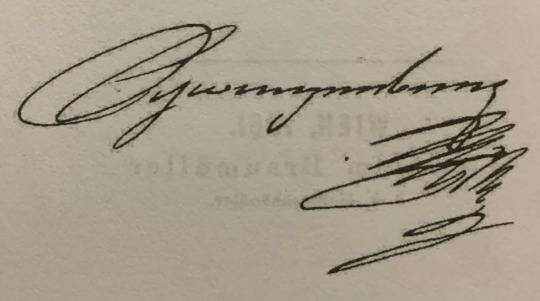
Now we can talk about the main piece of cake - Blücher‘s letter written in German! No doubt, there was a lot to describe after such a hard-fought battle. 😅
You can examine marshal’s signature as well. I’ll leave all the judgements to you, my dear readers!
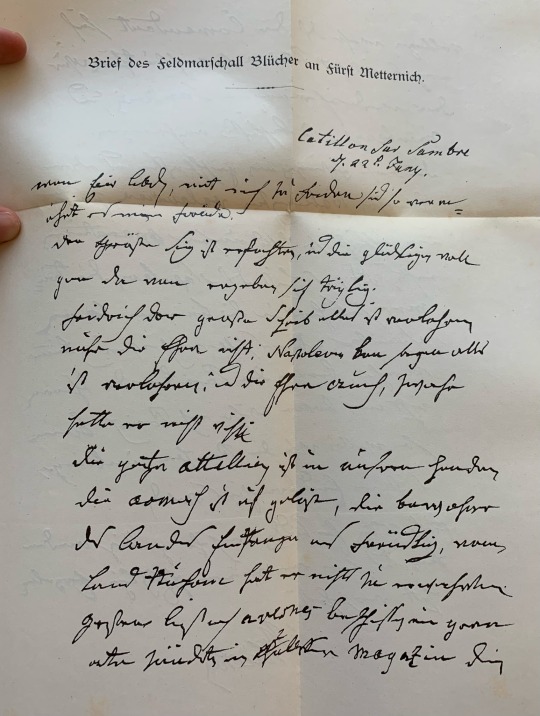

And the man who closes the selection for today is the victor at Waterloo himself - here’s a later sample of Arthur Wellesley’s handwriting which will serve us as a cherry on top of the Austro-Prussian cake. 🇬🇧

Thank you for your attention as always! 💗
#historical handwritings#karl zu schwarzenberg#klemens von metternich#gebhard leberecht von blücher#field marshal blücher#arthur wellesley#duke of wellington#napoleonic era#napoleonic wars#19th century
49 notes
·
View notes
Text


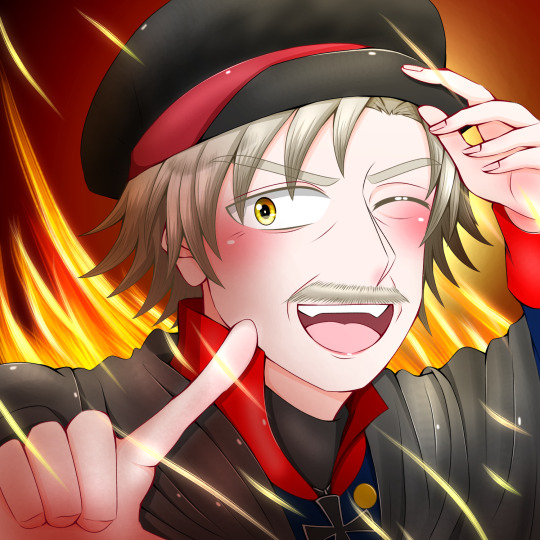
6/18/1815
#歴史創作#my art#napoleonic#19th century#napoleon bonaparte#arthur wellesley#Gebhard Leberecht von Blücher#battle of waterloo
12 notes
·
View notes
Text
Wehe dem Fürsten, wehe dem Volke also, das einen unrechtmäßigen Krieg aus bloßem Ehrgeiz anfängt.
Woe to the ruler, so woe to the nation, who start an illegitimate war out of mere ambition.
Gebhard Leberecht von Blücher (1742 – 1819), Prussian Field Marshal General
81 notes
·
View notes
Photo

During the campaign of 1806/1807, Prussian general Blücher had to capitulate to Murat, Bernadotte and Soult. He was taken captive, but it was arranged for him to be exchanged against French general Victor.
Translated from: Carl Blasendorff, "Gebhard Leberecht von Blücher"
The certainty of his imminent liberation filled the general with such joy that he drank to Napoleon's health over lunch at LeCamus'. On the following day he set off [...] The journey went first to Liebstadt. Here Blücher visited Marshal Soult and had a very lively conversation with him about the battle at Lübeck; in order to make himself understood he used French and German, even Polish words. If someone else wanted to translate the foreign expressions, the marshal declared it unnecessary, as the general's eyes already indicated what he meant. Of course, the Frenchman did not refrain from expressing his appreciation of Blücher's bold move.
I love all scenes with Soult and Blücher together because I imagine them to be utter opposites: Soult, the guy with only one facial expression (sullen) and Blücher, that 64-year-old spitfire. I assume Soult was greatly amused by Blücher's conversational skills.
45 notes
·
View notes
Text
De Waterloostraat in 1950.
Deze straat werd aangelegd in 1865, toen het halve eeuwfeest van de slag bij Waterloo werd gevierd. In juni van dat jaar wordt de naam voor het eerst vermeld. Ze is door de bouwondernemer gegeven.
De Slag bij Waterloo was een veldslag bij Waterloo, een plaatsje destijds gelegen in de Zuidelijke Nederlanden, tegenwoordig in België. Napoleon Bonaparte werd hier op 18 juni 1815 definitief verslagen door een coalitie van enerzijds Britse, Nederlandse en Hannoverse eenheden onder opperbevel van de hertog van Wellington en anderzijds een Pruisisch leger onder commando van maarschalk Gebhard Leberecht von Blücher. De 19e-eeuwse Britse historicus Edward Creasy rekende de Slag bij Waterloo onder de vijftien meest beslissende veldslagen in de wereldgeschiedenis.
Na in 1814 verbannen te zijn naar Elba, keerde Napoleon in maart 1815 naar Frankrijk terug. Hij installeerde zich daar opnieuw als keizer van Frankrijk. Zijn oude vijanden konden dat niet aanvaarden en vormden de Zevende Coalitie om hem weer te verjagen. Engeland en Pruisen trokken grote legers samen in de zuidelijke Nederlanden om Frankrijk op 1 juli 1815 binnen te vallen. Napoleon besloot ze voor te zijn en trok op 14 juni de grens van het Verenigd Koninkrijk der Nederlanden over bij Charleroi. De beslissende slag vond plaats bij Waterloo.
De foto is gemaakt door de Fototechnische Dienst Rotterdam en komt uit het Stadsarchief Rotterdam. De informatie komt eveneens uit het Stadsarchief Rotterdam en van Wikipedia.
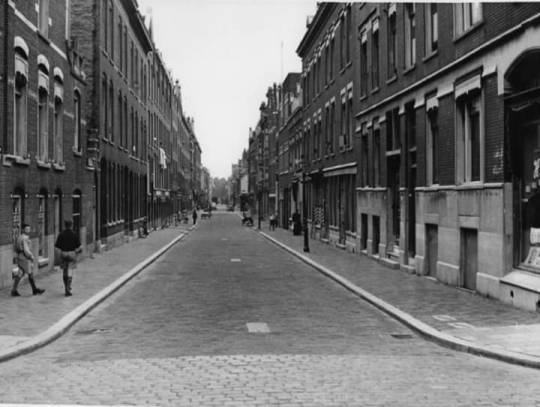
0 notes
Text


Waterloo (1970)
63 notes
·
View notes